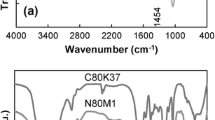Abstract
Organophilic sodium montmorillonite (Na-MMT) and Laponite-RD clays were incorporated into photopolymerizable hydroxyethyl starch (HES) modified with 2-hydroxyethyl methacrylate (HEMA). Swelling, mechanical properties and thermal stability of obtained crosslinked nanocomposite polymers were evaluated. A camphorquinone-amine system was used as photoinitiating system in visible light. The interaction between nano-sized filler particles and polymer hydrogel was evaluated by FT-IR spectroscopy and the platelet distribution was investigated by SEM. An increased thermal stability of nanocomposite polymers upon addition of clay was observed by thermogravimetric analysis (TGA) and differential scanning calorimetry (DSC) indicating interaction between the clay platelets and the polymer chains. The crosslinking density for HES-HEMA/MMT nanocomposite hydrogels as investigated by swelling measurements increases with increasing the organo-clay content. The mechanical properties of virgin hydrogels were improved by the introduction of organo-clay as evidenced by oscillation rheology measurements. Whereas, the increase in crosslink density and storage modulus with clay content for laponite was found to be increasing for all concentrations investigated, for MMT there is an optimum content of ca. 1.5 wt%.









Similar content being viewed by others
References
Zhao H, Argoti SD, Farrel BP, Shipp DA (2003) Polymer-silicate nanocomposites produced by in situ atom transfer radical polymerization. J Polym Sci A: Polym Chem 42:916–924
Van Dijk-Wolthuis WNE, Hoogeboom JAM, van Steenbergen MJ, Tsang SKY, Hennink WE (1997) Degradation and release behavior of dextran based hydrogels. Macromol 30:4639–4645
Schwoerer A, Harling S, Scheibe K, Menzel H, Daniels R (2009) Influence of degree of substitution HES-HEMA on the release of incorporated drug models from corresponding hydrogels. Europ J Pharm Biopharm 73:351–356
Cook WD (1992) Photopolymerization kinetics of dimethacrylates using the camphorquinone/amine initiator system. Polym 33:600–609
Kamoun E, Menzel H (2010) Crosslinking behavior of dextran modified with hydroxyethyl methacrylate upon irradiation with visible light-effect of concentration, coinitiator type and solvent. J Appl Polym Sci 117:3128–3138
Yeh JM, Liou SJ, Lin CY, Cheng CY, Chang YW, Lee KR (2002) Anticorrosively enhanced PMMA clay nanocomposite materials with quaternary alkylphosphonium salt as an intercalating agent. Chem Mater 14(1):154–161
Wu HC, Chang RC, Ou HJ, Peng DJ (2010) Case study on prevention of fire hazards in coating epoxy-based FRP work with illumination. J Loss Prevention in the Process Industries 23:346–350
Haraguchi K, Takehisa T (2002) Nanocomposite Hydrogels: A Unique Organic-Inorganic Network Structure with Extraordinary Mechanical, Optical, and Swelling/De-swelling Properties. Adv Mater 14:1120–1124
Pomogalio AD (2000) Hybrid polymer/inorganic nanocomposites. Russ Chem Rev 69:53–80
Kickelbick G (2003) Concepts for incorporation of inorganic building blocks into organic polymers on a nanoscale. Prog Polym Sci 28:83–114
Castelvetro V, De Vita VC (2004) Adv Colloid Interface Sci 108–109:167–185
Bourgeat-Lami E (2002) J Nanosci Nanotechnol 2:1–24
Bourgeat-Lami E (2004) In Encyclopedia of Nanoscience and Nanotechnology; American Scientific Publisher, Los Angeles 8:305–332
Bandi S, Bell M, Schiraldi DA (2005) Temperature-responsive clay aerogel- polymer composites. Macromol 38:9216–9220
Giannelis EP (1996) Polymer Layered Silicate Nanocomposites. Adv Mater 8:29–35
Velde B (1992) Introduction to Caly Minerals-Chemistry, Origins, Uses, and Environmental Significance. Geolog. J. Chapman-Hall, London
Lee WF, Ju LL (2004) Effect of the intercalation agent content of montmorillonite on the swelling behavior and drug release behavior of nanocomposite hydrogels. J Appl Polym Sci 94:74–82
Yano K, Usuki A, Okada A (1997) Synthesis and properties of polyimide-clay hybrid films. J Polym Sci Polym Chem 35(11):2289–2294
Worrall WE (1986) Clays and Ceramics Raw Materials. 2nd Ed. Elsevier Applied Science Publishers Chap 3:36–42
Shemper BS, Morizur J-F, Alirol M, Demenech A, Hulin V, Mathias LJ (2004) Synthesis clay nanocomposite-based coatings prepared by UV-cure photopolymerization. J Appl Polym Sci 93:1252–1263
Ferse B, Richter S, Arndt K-F, Richter A (2007) Investigation of gelling aqueous clay dispersions with dynamic light scattering. Macromol Symp 254:378–385
Haraguchi K, Franworth R, Ohbayashi A, Takehisa T (2003) Compositional effects of mechanical properties of nanocomposite hydrogels composed of poly (N, N-dimethyacrylamide) and clay. Macromol 36:5732–5741
Haraguchi K, Takehisa T, Ebato M (2006) Control of cell cultivation and cell sheet detachment on the surface of polymer/clay nanocomposite hydrogels. Biomacromol 7:3267–3275
Borsacchi S, Geppi M, Ricci L, Ruggeri G, Veracini CA (2007) Interaction at the surface of organophilic-modified laponites: A multinuclear solid state NMR study. Langmuir 23:3953–3960
van Dijk-Wolthuis WNE, Tsang SKY, Kettenes-van den Bosch JJ, Hennink WE (1997) A new class of polymerizable dextrans with hydrolyzable groups: hydroxyethyl methacrylated dextran with and without oligolactate spacer. Polym 38:6235–6242
Harling S, Schwoerer A, Scheibe K, Daniels R, Menzel H (2010) A new hydrogel drug delivery system based on hydroxyethylstarch derivatives. J Microencapsul 27:400–408
Yeh JM, Liou SJ, Lai CY, Wu PC (2001) Enhancement of corrosion protection effect in polyaniline via the formation of polyaniline-clay nanocomposite materials. Chem Mater 13:1131–1136
Guo X, Peng Z, Spencer P, Wang Y (2009) Effect of initiator on photopolymerization of acidic, aqueous dental model adhesives. J Biomed Mater Res 90A:1120–1127
Kim S-H, Won C-Y, Chu C-C (1999) Synthesis and characterization of dextran-maleic acid based hydrogel. J Biomed Mater Res 46:160–170
Yeh JM, Liou SJ, Chang YW (2004) Polyacrylamide-clay nanocomposite materials prepared by photopolymerization with acrylamide as an intercalating agent. J Appl Polym Sci 9:3489–3496
Wang HW, Chang KC, Chu HC (2005) Effect of clay on the properties of poly(styrene-co-acrylonitrile)-clay nanocomposite. Polym Int 54:114–119
Paranhos CM, Soares BG, Oliveira RN, Pessan LA (2007) Poly (vinyl alcohol)/clay-based nanocomposite hydrogels:swelling behavior and characterization. Macromol Mater Eng 292(5):620–626
Lee WF, Fu YT (2003) Effect of Montmorillonite on the swelling behavior and drug-release behavior of nanocomposite hydrogels. J Appl Polym Sci 89:3652–3660
Author information
Authors and Affiliations
Corresponding author
Additional information
E.A. Kamoun gratefully acknowledges Egyptian Ministry of Higher Education and Scientific Research for its financial support and grant.
Rights and permissions
About this article
Cite this article
Kamoun, E.A., Menzel, H. HES-HEMA nanocomposite polymer hydrogels: swelling behavior and characterization. J Polym Res 19, 9851 (2012). https://doi.org/10.1007/s10965-012-9851-3
Received:
Accepted:
Published:
DOI: https://doi.org/10.1007/s10965-012-9851-3




